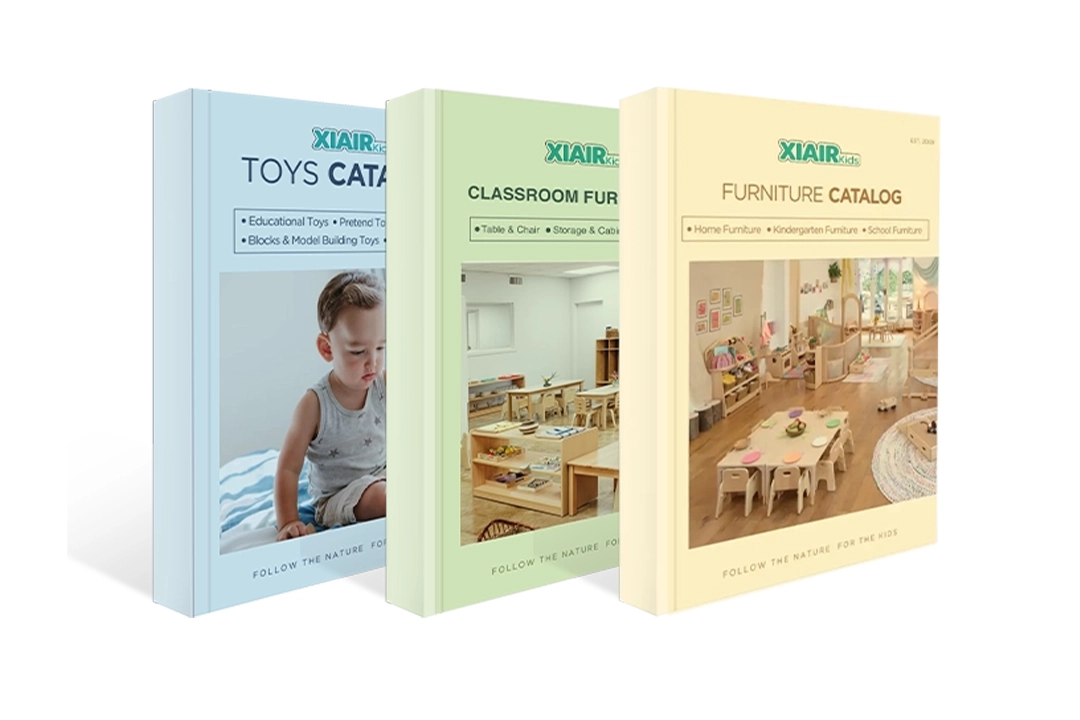There are many Christmas party games here.Before the holidays, families look forward to cozy gatherings, laughter, and warm shared moments. Once the gifts are wrapped and decorations are up, we often ask: how can we make this season magical for kids?
The answer is really a mix of simple planning and a playful spirit. Many Christmas games are not only fun but also helpful for children’s development. That’s why Christmas party games for kids at home matter so much. They turn an ordinary gathering into a warm and memorable celebration. Without a plan, kids might lose interest during the party, but with the right games, parent involvement, and an inviting atmosphere, the whole event becomes lively, engaging, and full of laughter.
This article is your guide to creating that festive atmosphere. Inside, you’ll find why these games matter, 21 fun and easy activities to try, tips for involving adults and ideas to start your party right. Let’s make this holiday one children will cherish.crash,skwhhs

Why Christmas Party Games for Kids Matter During the Holidays?
1. Fun and beneficial
Christmas Party Games for Kids go beyond simple amusement — they create meaningful connections. When children play, laugh, and cooperate, they develop communication skills, empathy, and confidence. Research shows that such shared play experiences strengthen social bonds and leave lasting memories that extend well beyond the holiday gathering.
2. Structure and Balance
Games add valuable structure to what might otherwise become a chaotic or dull evening. After dinner or gift-opening, a lineup of quick, ready-to-go activities like races, treasure hunts, or calm-down games helps hosts maintain the perfect festive rhythm. This balance keeps energy levels high yet manageable throughout the celebration.
3. Festive Spirit and Creativity
Holiday-themed games make the season come alive. Transforming “Simon Says” into “Santa Says” or organizing a “Candy Cane Hunt” infuses playtime with the colors, scents, and imagery of Christmas. Activities like “Pin the Nose on the Snowman” and “Snowman Stack” bring laughter while reinforcing the joyful spirit that defines the holidays.
4. Simplicity and Warmth
In today’s smaller home gatherings, practical and low-prep games make hosting easier and more personal. Parents and teachers alike find that simple activities fit perfectly into cozy celebrations. When games are tailored to each child’s age and energy, they convey care and thoughtfulness, reminding every child that their joy truly matters.

21 Activities for Kids at Christmas Parties
Here are 21 creative ideas designed for home celebrations that you can implement for your Christmas Party Games for Kids at Home. You don’t have to use all of them pick the ones that fit your space, age‑range, and schedule. Many are inspired by expert lists of holiday games for kids.
1. Candy Cane Hunt

This beloved classic is an easy and exciting way to start the party. Hide candy canes throughout your home or yard in both obvious and tricky places. When the game begins, children are given bags or small baskets and are challenged to collect as many candy canes as they can before time runs out. You can even include special “golden” candy canes for bonus prizes. It encourages movement, observation, Improve observation skills and lots of giggles.
Recommended Age: 3–10years
- Mini candy canes
- Small baskets or bags
- Optional: “golden” candy cane for bonus prize
2. Pin the Nose on the Snowman (or Rudolph)
This festive twist on “Pin the Tail on the Donkey” is always a hit with younger kids. Set up a large snowman or reindeer poster on the wall, blindfold each player, spin them gently, and have them attempt to place the carrot nose (or red nose) in the correct spot. There’s guaranteed laughter as noses end up on foreheads or far off the mark.This can help children improve their balance.

Recommended Age: 4–12years
مواد:
- Snowman or reindeer poster
- Paper noses
- Blindfold
- شريط
3. Santa Says
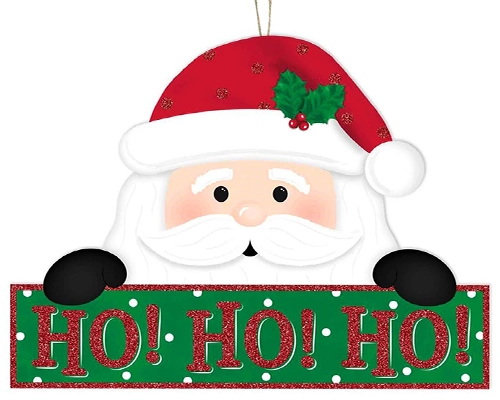
“Santa Says” is a holiday-themed variation of the familiar game “Simon Says,” perfect for engaging younger children. One leader gives commands like “Santa says march like a toy soldier” or “Santa says twinkle like a Christmas light.” Children must only obey if the instruction begins with “Santa says.” It’s a great warm-up or transition activity.It can also help children improve their communication skills.
4. Snowball Relay Race
Energetic and competitive, this relay race gets kids moving. Divide them into teams and give each child a “snowball” (a soft item like a balled-up sock) to carry across a room using a spoon. If the snowball drops, they must return to the start. The team that finishes first wins. It’s great for burning energy and practicing balance and coordination.

Recommended Age: 5–14 years
مواد:
- Rolled-up white socks or cotton balls
- Spoons
- Floor markers or cones
لا تحلم فقط، بل صممه! دعنا نتحدث عن احتياجاتك من الأثاث المخصص!
5. Christmas Cookie Face
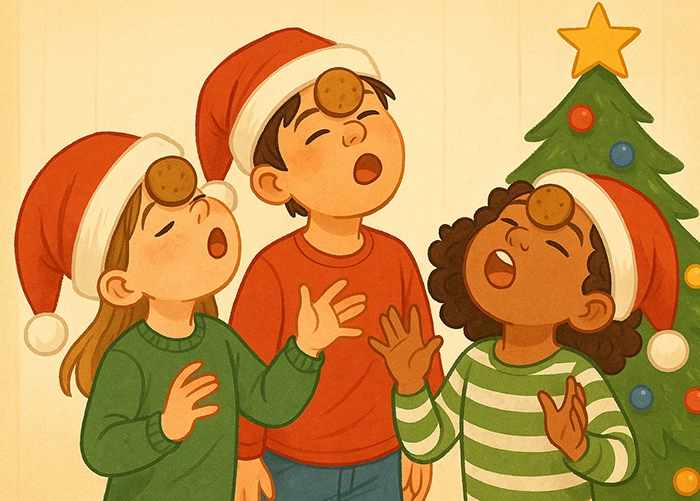
A hilarious challenge that’s fun to watch and to play. Kids place a cookie on their forehead and try to maneuver it into their mouth using only their facial muscles, no hands allowed! The first to succeed wins, or you can keep playing until everyone has a turn.This game encourages patience, focus, and silly expressions, making it a memorable highlight of any Christmas celebration.
Recommended Age: 6–12 years
مواد:
- Round cookies
- tissue
6. Christmas Bingo
Christmas Bingo is a calm and engaging game that works beautifully between active games. Use custom bingo cards filled with festive icons like candy canes, snowflakes, or elves. Children mark their cards as images are called out. The first to complete a row shouts “Bingo!” and gets a prize.

Recommended Age: 5–12 years
مواد:
- Printable bingo cards
- علامات
- Call-out cards or list
7. Gift Wrap Relay

Challenge kids to a race where they must wrap a gift box using one hand, with a partner, or while blindfolded. This team-based game combines laughter with skill as kids race against time to wrap presents neatly or at least wrap them somehow. Improve children’s hands-on skills and perfect for older children who like a little challenge
Recommended Age: 6–12 years.
مواد:
- Small boxes
- Wrapping paper
- شريط
- Ribbons or bows
8. Christmas Trivia or “Name That Christmas Song”
Test children’s holiday knowledge with fun trivia or snippets of classic Christmas songs. Split into teams, ask questions like “Name three of Santa’s reindeer” or play a few seconds of a song and have teams guess the title. Ideal for older kids, this game brings a fun, educational twist to the festivities.
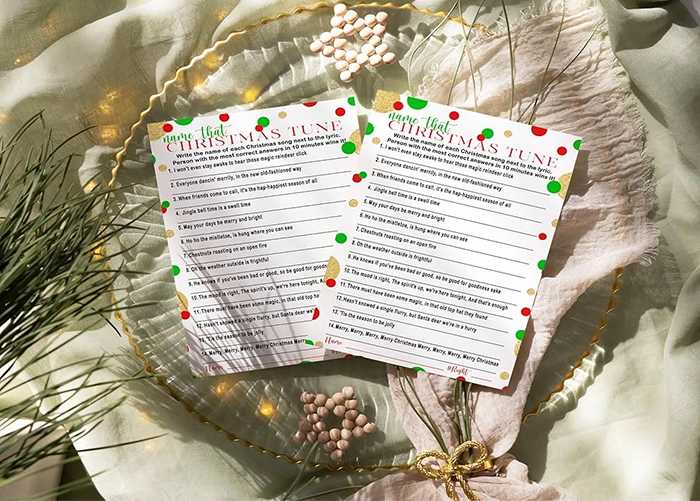
Recommended Age: 8–12 years
مواد:
- Christmas trivia questions
- Music clips and speaker
- Scoreboard or notepad
9. Snowman Stack

Kids are challenged to build a vertical stack using marshmallows or cups to represent a snowman. It sounds simple, but balancing soft, rounded items isn’t as easy as it looks. Kids compete to see who can make the tallest, most stable snowman in a limited time.This can help children improve their balance.
Recommended Age: 4–8 years
مواد:
- Large marshmallows or plastic cups
- Timer
10. Toilet Paper Snowman Race
Children pair up for this silly race. One becomes the “snowman” while the other wraps them in toilet paper from head to toe. Once wrapped, they can add accessories like scarves or hats. Judges award prizes for the fastest, neatest, or funniest creations.
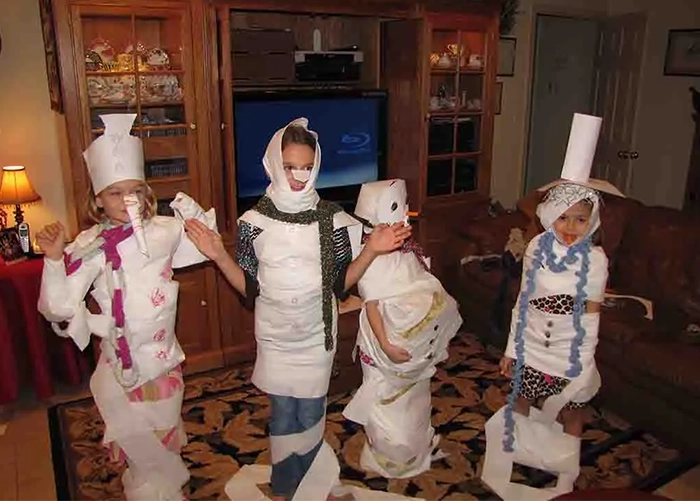
Recommended Age: 5–10 years
مواد:
- Toilet paper rolls
- Hats, scarves, or paper buttons
- Optional: sunglasses or gloves for decoration
11. Christmas Charades / Pictionary

Choose whether you want kids acting or drawing , either way, this game sparks imagination. Split the group into teams. Each player takes turns either drawing or acting out a holiday-related phrase while their team guesses. It’s perfect for encouraging creativity and teamwork.
Recommended Age: 6–12 years
مواد:
- Holiday-themed prompts
- Timer
- Drawing paper and markers
12. Christmas Tree Bowling
Transform your hallway into a bowling lane. Stack cups or bottles decorated like Christmas trees and have children roll a soft ball to knock them down. You can increase difficulty by adjusting the distance or using smaller balls.Children can take turns rolling and cheering for each other, keeping score for a friendly competition. This simple yet active game helps improve coordination and balance while bringing a joyful energy to your Christmas celebration.
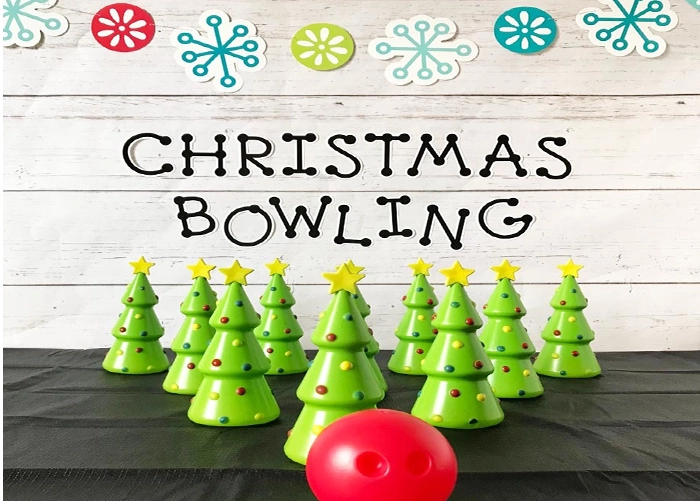
Recommended Age: 4–8 years
مواد:
- Green cups or decorated bottles
- Soft ball
13. Escape Room – Holiday Style

This game is a challenge-based mystery for older children. Create a storyline like “Santa’s Sleigh is missing” and hide clues around the house. Kids work in teams to solve puzzles and unlock the final answer. It requires more prep but delivers high engagement and excitement.
Recommended Age: 9–16 years
مواد:
- Written clues
- Lockable box or envelope
- Timer
- Small reward for the end
14. Reindeer Antler Ring Toss
Make it even more exciting by letting kids take turns being the “reindeer” while others aim the rings. Use soft rings made from rope, glow sticks, or even paper plates to keep it safe and easy indoors. This cheerful game builds teamwork, coordination, and plenty of giggles, making it a favorite for any Christmas party.
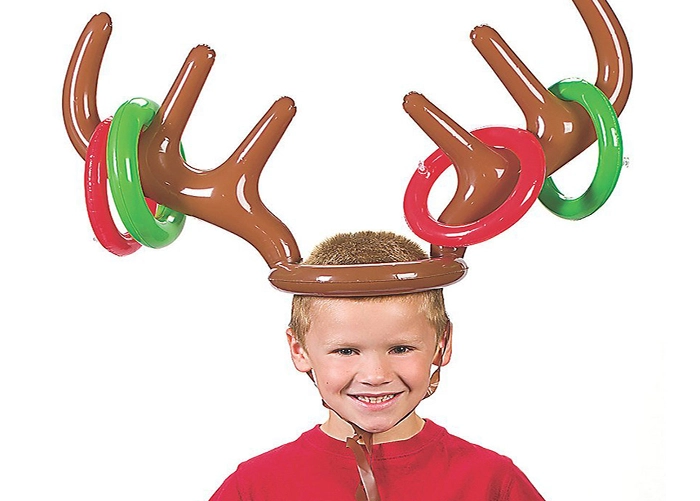
Recommended Age: 4–10 years
مواد:
- Reindeer antler headband or cardboard version
- Rings
15. Jingle Bell Toss with Math Twist

Set up the game using paper cups, gift boxes, or decorated containers placed at different distances. Use small jingle bells or pom-poms as toss items, and assign higher points to cups that are farther away. Children can take turns tossing and adding up their scores, practicing counting and coordination while enjoying festive laughter.
Recommended Age: 5–9 years
مواد:
- Plastic cups with numbers
- Jingle bells
16. Build a Snowman Relay
Split kids into teams. Each child runs to a “snowman zone” to add an item like a foam ball, scarf, or paper button to their team’s snowman. The team that completes their snowman the fastest and keeps it standing wins.This can help children improve their physical coordination.

Recommended Age: 5–10 years
مواد:
- Foam balls or balloons
- Hats, scarves, and paper buttons
- Tape or pins
لا تحلم فقط، بل صممه! دعنا نتحدث عن احتياجاتك من الأثاث المخصص!
17. Guess the Number of Candies
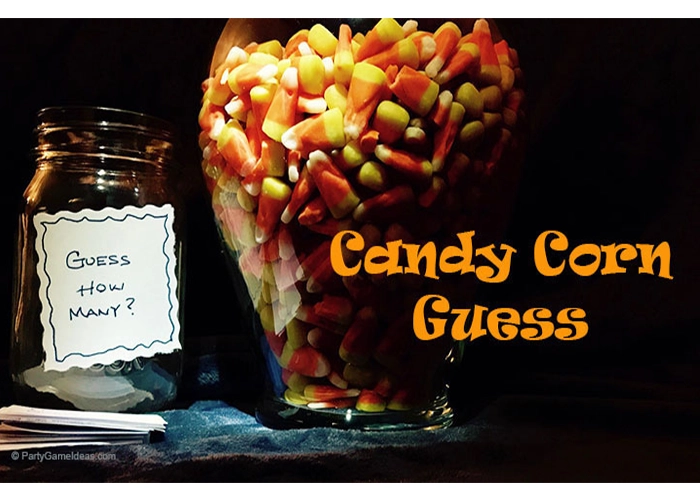
You can use red and green candies, peppermints, or chocolate kisses to make the jar look festive and eye-catching. Display it on a table where everyone can see it, and let children write their guesses on small cards. This game builds excitement and adds a sweet holiday touch to the celebration.
Recommended Age: 4–12 years
مواد:
- Jar with candies
- Slips of paper for guesses
- Pen or pencil
18. Holiday Picture Drawing Challenge
Ask kids to draw holiday pictures but there’s a twist. Given a specific topic, based on their thoughts, they must draw while holding the paper plate on their head! It’s hilarious to see the finished artwork and vote on the best or funniest creations.This playful game sparks creativity and laughter as kids try to balance drawing and imagination.

Recommended Age: 5–10 years
مواد:
- أطباق ورقية
- أقلام التحديد أو أقلام التلوين
19. Pin the Halo on the Angel
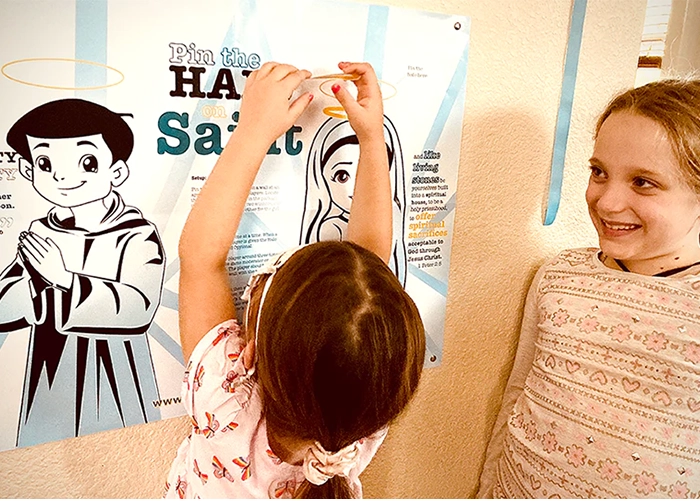
This peaceful alternative to more active games involves blindfolding kids and letting them place halos or stars on a Christmas character. It’s ideal for religious or quiet holiday settings, and still allows for lots of giggles when halos land in odd places.It can also improve children’s balance.
Recommended Age: 5–9 years
مواد:
- Poster of angel or nativity
- Paper halos or stars
- Blindfold
- شريط
20. Christmas stocking selection
Kids sit in a circle and pass a stocking around while holiday music plays. When the music stops, the child holding the stocking performs a quick silly task , like singing a carol or doing a reindeer impression. Continue until everyone’s had a turn.This can train a child’s reaction ability.Be careful not to hold the Christmas stocking for more than five seconds.
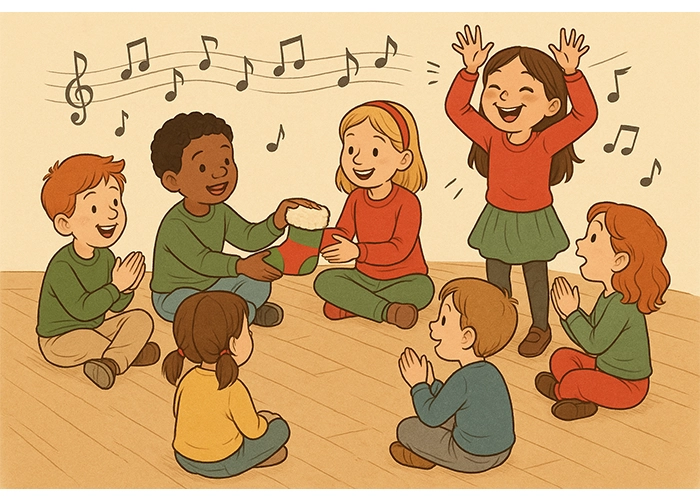
Recommended Age: 4–10 years
Kids sit in a circle and pass a stocking around while holiday music plays. When the music stops, the child holding the stocking performs a quick silly task , like singing a carol or doing a reindeer impression. Continue until everyone’s had a turn.Be careful not to hold the Christmas stocking for more than five seconds.
مواد:
- Small stocking filled with stuffing
- Music player
21. Family Bell or Candy Stack
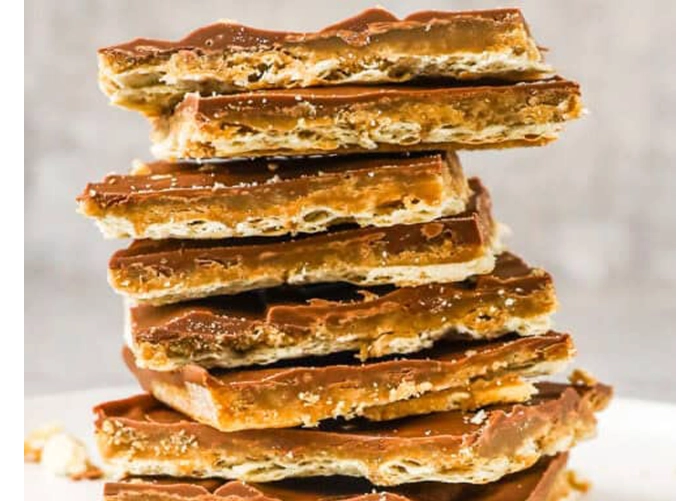
Give each child a stackable item like bells or wrapped candies. Set a timer and see who can build the tallest tower in 60 seconds. It’s quick to reset and replay, and works well near the end of the party.This game can enhance children’s balance skills, combining education with fun.
Recommended Age: 6–12 years
مواد:
- Timer
- Jingle bells, wrapped candies, or plastic cups
Tips for using these safely and effectively at home:
- Check your available space and adapt games accordingly ,avoid breakable items, secure furniture if kids will run.
- Ensure age‑appropriate modifications ,younger children may need simpler rules or smaller distances.
- Keep a mix of high‑energy relay races and calm games like trivia, bingo so kids don’t burn out too quickly.
- Have small prizes ready ,stickers, extra candy canes, certificates to motivate and reward participation.
- Consider parent involvement to help supervise, cheer, and maintain smooth transitions.
With this list, you’re well‑equipped to host a lively, memorable home party that leans into fun, festivity, and kid‑friendly energy. Up next: how to involve parents so everyone can join in.
How to Involve Parents in Kids’ Christmas Party Games?
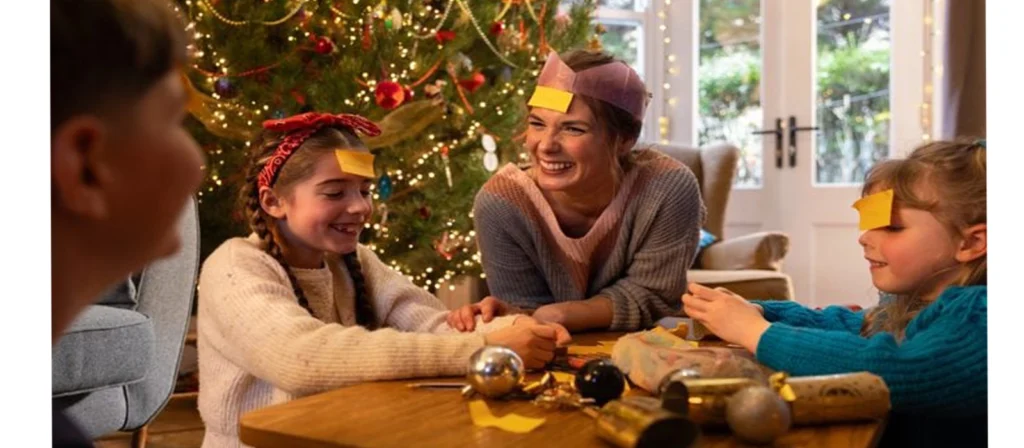
When planning Christmas Party Games for Kids at Home, involving parents adds warmth, organization, and a sense of togetherness. Parents can take on supportive roles that keep the event running smoothly while creating shared memories with their children.
1. Assign Roles Ahead of Time
Before the party begins, prepare a short list of game roles and invite parents to take part. For example, one parent can lead the “Candy Cane Hunt,” another can manage the prize table, while someone else captures photos and videos. Having clear roles helps the Christmas party stay organized and allows every parent to feel part of the celebration.
2. Use Parents for Safety and Transition Management
Active games such as relays or snowball tosses need adult supervision. Parents can help set up safe play zones, clear breakables, guide children between games, and keep an eye on little ones who might wander off. Their presence creates a relaxed and secure atmosphere for everyone.
3. Encourage Parent-Child Teaming
Make some games collaborative by pairing children with their parents. In activities like “Jingle Bell Toss” or “Gift Wrap Relay,” these pairs can compete together. It strengthens bonds, builds cooperation, and ensures younger children get the support they need.
4. Provide a Simple Script or Briefing for Parents
Before the party begins, give parents a quick overview of each game , including setup, rules, and timing cues. A short guide helps avoid confusion, keeps the event flowing, and ensures every adult knows how to help when it’s time to switch games.
5. Communicate with Parents Before the Party
Send a cheerful message or note ahead of time: “Here’s our Christmas Party Games schedule , we’d love your help!” Include what to bring (like candy canes or small prizes) and ask if they can arrive a few minutes early to assist with setup. When parents are informed, they’re far more eager to join in.
6. Keep Transitions Smooth and Cheerful
Parents can help children move between games, gather props, and line up for the next round. This keeps the excitement going and prevents downtime that could lead to restlessness.
By engaging parents as active participants, your Christmas party becomes more than just a fun event , it turns into a shared family experience filled with laughter, connection, and teamwork. Adults aren’t just watching; they’re creating joyful moments alongside their kids.
لا تحلم فقط، بل صممه! دعنا نتحدث عن احتياجاتك من الأثاث المخصص!
Start Your Celebration with a Christmas Party Invitation for Kids

Before the games begin and the laughter fills the room, setting the stage with a well‑designed invitation elevates the experience. An invitation signals to the kids that this event is special, not just another gathering, and builds anticipation. Here’s how to craft one tailored to your “Christmas Party Games for Kids at Home”.
1. Choose the Look and Feel
Select an invitation design that reflects your theme: red and green, snowflakes, candy canes, reindeer, Santa hats. Whether digital or printed and mailed, a festive design cues holiday excitement. Use imagery kids recognize: stockings, Christmas tree ornaments, snowmen.
2. Include Key Information with Game‑Friendly Language
Your invitation should clearly communicate the essential details:
- Date and time of the party
- موقع
- A brief mention of fun games: for example: “Join us for a fun afternoon packed with 21 fun and easy Christmas Party Games for Kids at Home , Candy Cane Hunt, Snowman Stack, Santa Says and more!”
- What kids should bring: optional hat, comfy clothes, empty hands for games, a small prize to swap perhaps
- Any special instructions: e.g., “We’ll start play at 3:00 pm , please arrive 10 minutes early so we can begin on time.”
3. Add a Personal Touch
Hand‑write or digital‑sign the invitation with a short message: “We can’t wait to play and celebrate with you!” Kids love seeing their name on the invite. If you’re sending electronically, consider a festive GIF or picture of the game supplies like candy canes, bells to spark interest.
4. Make it Interactive
For added excitement, include a “choice” snippet: “Which game are you most excited for? Candy Cane Hunt or Build a Snowman Relay? Let us know!” This gives kids ownership and gets them thinking about the games ahead.
5. Provide a Clear RSVP and Parent Info
Ask for a quick RSVP so you can manage game planning. Include a note for parents: “We’ll have adult volunteers helping with games. Let us know if you can stay and assist.” That invites parent involvement and helps you plan adult support.
6. Offer a Small Pre‑Party Activity
On the invitation, you might mention: “Arrive at 2:45 pm for a hot cocoa & ornament decorating before games begin.” This gives families a reason to arrive early, sets the mood, and transitions smoothly into your main games list. It also reduces chaos when kids arrive.
7. Print or Send Reminders
A gentle reminder one day before the event helps parents and ensures kids come prepared. You might send a picture of one of the props or write: “Candy canes hidden, snowballs ready – see you tomorrow!” This builds excitement and ensures higher attendance.
By crafting a thoughtful invitation, you show that this party is deliberately planned with fun in mind. It primes kids for excitement and gives parents clarity. Next, let’s look at common mistakes to avoid when planning your children’s Christmas event.
How to avoid common mistakes when planning Christmas party games?

Even the best planned party can lose momentum if certain common pitfalls occur. To make your Christmas Party Games for Kids at Home run smoothly, here are mistakes to watch out for , and how to avoid them.
1. Too Many Games and Rushing Through
Hosting a long list of activities doesn’t guarantee more fun. In fact, rotating too quickly can overwhelm children or leave games incomplete. Kids may feel rushed, adults may lose control, and transitions can get chaotic.
حل: Pick a comfortable number of games ,for example 5‑7 main games plus 1 or 2 short ice‑breakers.depending on your time frame and participant age. Allow buffer time between for snack, rest, or free play. Use a parent or teacher to help transition.
2. Neglecting Age Differences
Kids of varying ages have different attention spans, coordination levels, and interest. A relay race may be thrilling for older kids, but stressful for younger ones.
حل: Choose games that can be modified for age groups; or group children by age where appropriate. For example, younger kids do a simplified version of “Santa Says”, while older kids do the full version. Ensure adult supervision and adapt rules accordingly.
3. Overlooking Safety and Space
High‑energy games in a cramped or cluttered room can lead to bumps, broken items, or upset kids.
حل: Clear a play area ahead of time: push back furniture, remove breakables, ensure floor is level and non‑slippery. For active games, define clear boundaries. Use soft props. Supervise adult‑led games.
4. Ignoring the Mix of Active vs Quiet Moments
If you fill the party only with active games, children may be exhausted or overstimulated before the party ends. Conversely, only quiet games could lead to restlessness and boredom.
حل: Plan a mix: start with an active game follow with a quieter game include one brain‑game then recharge with snack or drink, then finish with a fun active assignment
5. Not Communicating with Parents or Teachers
When parent helpers or teachers don’t know their role, games may get delayed, rules mis‑explained, or kids left waiting.
حل: Prior to the event send a simple outline of games, roles, times, and responsibilities to parent and teacher helpers. Brief them 10 minutes before starting. Ensure they have what they need
6. Failing to Prepare Supplies or Backup Plan
Running out of props, missing prizes, or having a game stop midway because of missing items can kill the momentum.
حل: Prepare all materials ahead of time: props, candy canes, bells, timers, prizes. Have backup games ready , for example, an additional quiet game if one active game runs too long. Keep extra supplies handy.
7. Too Much Emphasis on Winning and Competition
While friendly competition can be fun, if kids feel left out, overwhelmed or overly competitive, it can reduce enjoyment.
حل: Emphasize participation, fun, and teamwork rather than just winning. Use teams rather than individual elimination when appropriate. Offer small prizes to everyone or celebrate fun categories (“Best Team Spirit”, “Silliest Pose”) rather than only “1st place”.
8. Neglecting the Invitation and Build‑Up
If the party begins with no clear signal of celebration or no build‑up, kids may arrive in casual mode and the energy may start flat.
حل: Use a festive invitation (see previous section) to build excitement. Begin with a short welcome and fun ice‑breaker so kids feel immediately engaged. Let parents know to arrive a bit early to transition from arrival to games.
By avoiding these mistakes and planning carefully, you ensure your Christmas Party Games for Kids at Home deliver joy, ease, and memorable moments. Let’s wrap up with a summary and some FAQs.
خاتمة
In this busy, bright holiday season, crafting an event for children that feels fun, festive, and meaningful takes intention, but it doesn’t have to be complicated. By focusing on Christmas Party Games for Kids at Home, you create an environment of laughter, connection, movement, and shared joy. You’ve seen why these games matter, discovered 21 hand‑picked fun and safe activities optimized for home settings, learned how to involve parents to elevate the experience, started strong with a thoughtful invitation, and avoided common planning pitfalls.
When you combine these elements, you give your children not just another holiday gathering, but a vivid memory they’ll carry forward. The laughter, the cheers, the sense of “we did this together”, those are the markers of a successful party.choose the games that fit your space, prepare your props, invite your helpers, and watch the magic unfold. Because when you intentionally plan fun, inclusive, and well‑paced games, the holiday shines a little brighter.
لا تحلم فقط، بل صممه! دعنا نتحدث عن احتياجاتك من الأثاث المخصص!
الأسئلة الشائعة
1. What age range works best for these Christmas Party Games for Kids at Home?
These games are designed to be flexible and adaptable for children roughly aged 4–12. For younger children (4‑6 yrs) choose simpler games like Candy Cane Hunt, Santa Says, or Cookie Face. For older children (8‑12 yrs) pick more challenging or team‑oriented games like Escape Room, Gift Wrap Relay, or Trivia. Adapt distances, rules, or time limits accordingly.
2. What age range works best for these Christmas Party Games for Kids at Home?
For a typical home party of 1.5‑2 hours, plan for about 45‑60 minutes of game time (including transitions), interspersed with a snack or break. This allows 4‑6 major games plus one or two quick extras. It avoids fatigue and keeps energy balanced.
3. What if I don’t have many supplies or props?
No problem. Many of the listed games require minimal cost: socks as snowballs, candy canes you may already have, paper and tape for posters, jingle bells from a holiday decoration box. Choose 3‑4 low‑prep games and skip or simplify custom ones. The key is fun and engagement, not fancy props.
4. Can older children and younger children play together in the same games?
Yes, with some adaptations. You might pair younger children with older ones or parents as mentors. Modify rules for younger kids . Some games like Bingo or Trivia can be done in teams mixing ages so everyone contributes.
5. How do we handle prizes without creating jealousy?
Offer small prizes for everyone who participates and then perhaps “special” tokens for winners . Emphasize fun and teamwork rather than strict ranking. Consider categories like “Best Team”, “Most Creative”, and “Best Effort” so more children are recognized.
6. What should we do if a game doesn’t go as planned or kids lose interest?
Have a backup game ready that requires minimal setup . Keep the mood light: say, “Let’s take five, grab some cocoa, and then we’ll do one more game.” Transition smoothly to maintain positive energy. Sometimes skipping a game is better than forcing one that drag.
فصلك الدراسي المثالي على بعد نقرة واحدة!



